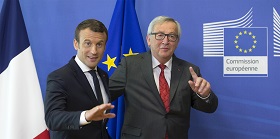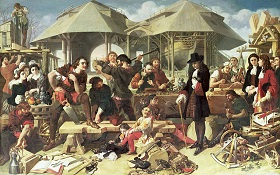The next elections for the European Parliament will take place on 23–26 May 2019 and the EU’s various political families are already mobilising. They will be crucial elections in a crucial year. 2019 promises tough times for Europe with Brexit, elections, and certainly more financial turbulences, which are already under way. Here we propose three short- and medium-term possible scenarios, none of which looks reassuring.
The most shocking possibility is of course that of a ‘Far Right’ win. A populist (although ‘nationalist’ seems to be a better term to define the newly-emerging parties on the right) parliamentary majority looks unlikely, but a strong result, especially in key big states, would have a profound impact. Italy’s League, led by ambitious and controversial Matteo Salvini, France’s National Front, and perhaps Germany’s Alternative fur Deutschland could join forces and make key gains in the Eurozone’s three largest countries. Hungary’s much-discussed Viktor Orban will probably remain in the moderate European People’s Party, but will certainly not favour pro-European policies, to put it mildly. Any success of nationalist right-wing parties will be disgraceful to European integration and will bring the continent back to a pre-World War Two era of small nation-states in perpetual fight against each other. Having said that, nationalist parties cannot be dismissed as ‘deplorable’ relics from the past – as Hillary Clinton unwisely disregarded Trump’s voters. In a sense, nationalist parties are the other side of a coin with the image of the Clintons, Blair, Schroeder, Prodi, and all those leaders who recklessly endorsed an unrestrained neoliberal globalisation in the 1990s and early 2000s. Millions of European voters feel betrayed by the centre-left’s embrace of neoliberalism (for example under the comforting label of ‘third way’ or ‘Neue Mitte’) in the golden age of globalisation and are attracted by nationalists’ reassuring (if misguided) message, especially on issues such as immigration and job security.
The next elections for the European Parliament will take place on 23-26 May 2019 and the EU’s various political families are already mobilising. They will be crucial elections in a crucial year. 2019 promises tough times for Europe with Brexit, elections, and certainly more financial turbulences, which are already under way. Here we propose three short- and medium-term possible scenarios, none of which looks reassuring.
The most shocking possibility is of course that of a ‘Far Right’ win. A populist (although ‘nationalist’ seems to be a better term to define the newly-emerging parties on the right) parliamentary majority looks unlikely, but a strong result, especially in key big states, would have a profound impact. Italy’s League, led by ambitious and controversial Matteo Salvini, France’s National Front, and perhaps Germany’s Alternative fur Deutschland could join forces and make key gains in the Eurozone’s three largest countries. Hungary’s much-discussed Viktor Orban will probably remain in the moderate European People’s Party, but will certainly not favour pro-European policies, to put it mildly. Any success of nationalist right-wing parties will be disgraceful to European integration and will bring the continent back to a pre-World War Two era of small nation-states in perpetual fight against each other. Having said that, nationalist parties cannot be dismissed as ‘deplorable’ relics from the past – as Hillary Clinton unwisely disregarded Trump’s voters. In a sense, nationalist parties are the other side of a coin with the image of the Clintons, Blair, Schroeder, Prodi, and all those leaders who recklessly endorsed an unrestrained neoliberal globalisation in the 1990s and early 2000s. Millions of European voters feel betrayed by the centre-left’s embrace of neoliberalism (for example under the comforting label of ‘third way’ or ‘Neue Mitte’) in the golden age of globalisation and are attracted by nationalists’ reassuring (if misguided) message, especially on issues such as immigration and job security.
In this sense, the forthcoming elections appear far from promising. The main opponent of the nationalist forces will be Emmanuel Macron, who champions a liberal and pro-EU project and is attempting to put together a European ‘dream team’ of liberals. A second scenario would thus be a major ‘dream team’ success. The Dutch premier Rutte has already announced he will join Macron and Spain’s Ciudadanos are expected to follow. Will the leader of the European liberals (ALDE, Alliance of Liberals and Democrats for Europe), 65-years old former Belgian premier Guy Verhofstadt, join as well? What about Italy’s Matteo Renzi, who has never made a secret of his Blairite sympathies?
Sadly, good European politics has little to do with a list of allegedly liberal stars. Liberal policies and a vague, generic support to supranational integration have already let Europe down in the 1990s and are in fact at the roots of many of its subsequent problems: it is unlikely European citizens will reward them any time soon. The likes of Blair and Schroeder have usually promoted civilian liberties (including those in other countries, often in a rather intrusive and arrogant fashion) but largely disregarded social rights, even in countries like Germany. As of 2017, 1.5 million Germans (some in the country’s richest regions) go to food banks. These conditions are to some extent the outcome of the job market reforms, which were introduced by Chancellor Schroeder in the early 2000s (the much-discussed ‘Hartz reforms’) and created a high number of precarious and little-paid ‘mini-jobs’.
It follows from what above that a third scenario – that of a ‘two-speed Europe’ – is neither feasible nor desirable. It is sometimes heard that European integration could move on among a small core of few, wealthy and culturally akin countries, mainly in Northern Europe and led by a ‘German motor’. This scenario might appeal to some fundamentalists of Ordoliberalismus in the Bundesbank and other German institutions and could perhaps gain some traction in countries such as the Netherlands or Finland. It is highly likely that the next Head of the European Central Bank will be a German or a German-sponsored candidate, and the perspective of a more limited and economically safer form of European integration might return to public debates. And yet it would not be a solution. First, ‘Northern European’ integration would not be a federation because no state would like to join a deep union in which Berlin would enjoy a leading, dominant position. Second, it would hardly benefit Germany itself, which needs large European partners (e.g. France, Italy, Poland) to invest and sell its products. Third, Germany has significant domestic issues and is hardly in the position to be able to revolutionise European affairs. In the recent Bavarian polls Alternative fuer Deutschland has obtained a valuable 10.2 percent, while the two historical parties’ (CDU/CSU and SPD) overall share of the votes has declined from 68.3 to 46.9 percent (with the SPD down from 42 to 22 seats). Interestingly, the exploit of the Greens (from 17 to 38 seats) in a traditionally conservative Land points to the possible rise of a leftist alternative to Germany’s more consolidated political forces. Similar considerations apply to the even more recent vote in Hesse, where a disappointing 27 percent for the CDU has pushed Angela Merkel to step down from the party leadership.
Europe is currently facing big dilemmas. No easy solutions are at hand. Those who will provide better and concrete answers will win: anger and resentment are widespread and Europeans are not in the mood to embrace dreams and niceties. Certainly, in the longer term, a divided continent will stand no chance against large, continental states such as the USA, China, Russia, India, even Brazil.







